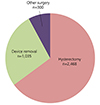1. Mino M, Arjona JE, Cordon J, Pelegrin B, Povedano B, Chacon E. Success rate and patient satisfaction with the Essure sterilisation in an outpatient setting: a prospective study of 857 women. BJOG. 2007; 114:763–766.
2. Thiel JA, Carson GD. Cost-effectiveness analysis comparing the essure tubal sterilization procedure and laparoscopic tubal sterilization. J Obstet Gynaecol Can. 2008; 30:581–585.
3. Levie MD, Chudnoff SG. Office hysteroscopic sterilization compared with laparoscopic sterilization: a critical cost analysis. J Minim Invasive Gynecol. 2005; 12:318–322.
4. Rezai S, LaBine M, Gomez Roberts HA, Lora Alcantara I, Henderson CE, Elmadjian M, et al. Essure microinsert abdominal migration after hysteroscopic tubal sterilization of an appropriately placed essure device: dual case reports and review of the literature. Case Rep Obstet Gynecol. 2015; 2015:402197.
5. Sills ES, Dalton MM. Referrals for complications following hysteroscopic sterilisation: characteristics associated with symptomatic patients after the Essure procedure. Eur J Contracept Reprod Health Care. 2016; 21:227–233.
7. Scarabin C, Dhainaut C. The ESTHYME study. Women's satisfaction after hysteroscopic sterilization (Essure micro-insert). A retrospective multicenter survey. Gynecol Obstet Fertil. 2007; 35:1123–1128.
8. Brito LG, Cohen SL, Goggins ER, Wang KC, Einarsson JI. Essure surgical removal and subsequent symptom resolution: case series and follow-up survey. J Minim Invasive Gynecol. 2015; 22:910–913.
11. Doll KM, Dusetzina SB, Robinson W. Trends in inpatient and outpatient hysterectomy and oophorectomy rates among commercially insured women in the United States, 2000-2014. JAMA Surg. 2016; 151:876–877.
12. Whiteman MK, Hillis SD, Jamieson DJ, Morrow B, Podgornik MN, Brett KM, et al. Inpatient hysterectomy surveillance in the United States, 2000-2004. Am J Obstet Gynecol. 2008; 198:34.
13. Anderson TL, Yunker AC, Scheib SA, Callahan TL. Hysteroscopic sterilization success in outpatient vs office setting is not affected by patient or procedural characteristics. J Minim Invasive Gynecol. 2013; 20:858–863.
14. Howard DL, Wall J, Strickland JL. What are the factors predictive of hysterosalpingogram compliance after female sterilization by the Essure procedure in a publicly insured population? Matern Child Health J. 2013; 17:1760–1767.
15. Sills ES, Li X, Jones CA, Wood SH. Contraceptive failure after hysteroscopic sterilization: analysis of clinical and demographic data from 103 unplanned pregnancies. Obstet Gynecol Sci. 2015; 58:487–493.
17. Adelman MR, Dassel MW, Sharp HT. Management of complications encountered with Essure hysteroscopic sterilization: a systematic review. J Minim Invasive Gynecol. 2014; 21:733–743.
18. Mao J, Pfeifer S, Schlegel P, Sedrakyan A. Safety and efficacy of hysteroscopic sterilization compared with laparoscopic sterilization: an observational cohort study. BMJ. 2015; 351:h5162.
19. Albright CM, Frishman GN, Bhagavath B. Surgical aspects of removal of Essure microinsert. Contraception. 2013; 88:334–336.
20. Lannon BM, Lee SY. Techniques for removal of the Essure hysteroscopic tubal occlusion device. Fertil Steril. 2007; 88:497.
21. Kraemer DF, Yen PY, Nichols M. An economic comparison of female sterilization of hysteroscopic tubal occlusion with laparoscopic bilateral tubal ligation. Contraception. 2009; 80:254–260.
22. Dhruva SS, Ross JS, Gariepy AM. Revisiting Essure: toward safe and effective sterilization. N Engl J Med. 2015; 373:e17.
23. la Chapelle CF, Veersema S, Brolmann HA, Jansen FW. Effectiveness and feasibility of hysteroscopic sterilization techniques: a systematic review and meta-analysis. Fertil Steril. 2015; 103:1516–1525.
24. Hoyos LR, Leon-Peters J, Berman JM, Hertz M. Pregnancy following hysteroscopic sterilization at an Urban Abortion Clinic. A case series: are we looking in the wrong places? Contraception. 2016; 94:78–80.
25. Sills ES, Fernandez LP, Jones CA. What is the economic cost of unplanned pregnancy following hysteroscopic sterilization in the US? A new national estimate based on Essure procedure prevalence, failure rates, and workforce productivity. World Health Popul. 2016; 17:31–38.
26. Kulseng-Hanssen S, Borstad E. The development of a questionnaire to measure the severity of symptoms and the quality of life before and after surgery for stress incontinence. BJOG. 2003; 110:983–988.
27. Larochelle A, Podoba J, Ouellet S, Fraser WD. Accuracy of recall in quality-of-life assessment among women operated on for stress urinary incontinence. Int Urogynecol J Pelvic Floor Dysfunct. 2009; 20:1233–1241.










 PDF
PDF ePub
ePub Citation
Citation Print
Print



 XML Download
XML Download